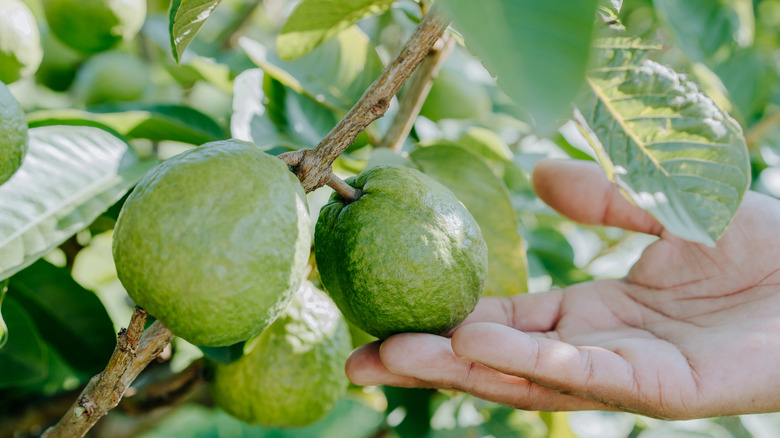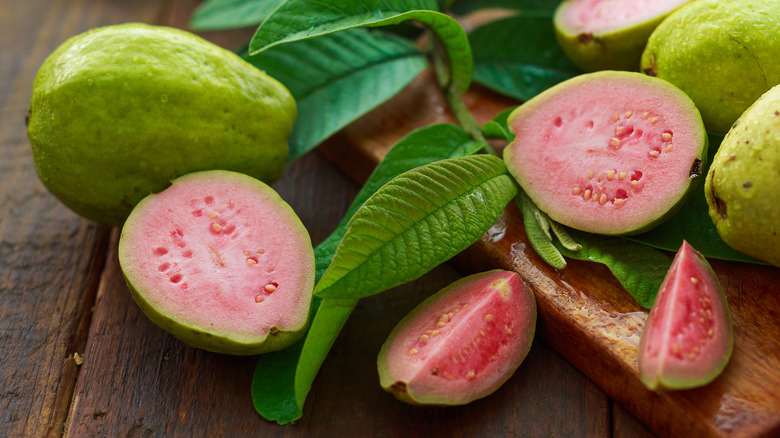How To Eat Guava Like A Total Fruit Connoisseur
With its vibrant green or yellow skin, guava looks similar to a round avocado. However, its flavor is rather sweet, with hints of strawberry and pear. Some varieties taste similar to passionfruit, while others have citrusy notes. Their size and color may vary, too. For example, Malaysian red guavas are relatively large and have sweet pink flesh. White guavas, on the other hand, taste like melon or passion fruit and have juicy, white flesh.
This tropical fruit grows in the Caribbean, India, South America, and other regions, and it's used in sweet and savory dishes alike. It can be a delightful addition to cheese soufflés, jams, BBQ sauce, pastries, bread pudding, and more. Guava is also one of the fruits you should be seasoning with salt, especially when unripe. After that, you can use it in savory meals and snacks, such as amrood ki sabzi, or guava curry, plus honey-glazed ribs and grilled chicken kebabs.
As you can see, there are quite a few ways to eat guava. You can enjoy it as is, add it to cooked meals, mix it into smoothies, and much more. Every part of it is edible, including the skin, seeds, and leaves. Its flesh is chock-full of fiber, protein, potassium, and vitamin C, offering a hefty nutritional punch. That said, it's easy to eat this exotic fruit so you can fully reap its benefits.
What's the best way to eat guava?
Guava is tasty in homemade desserts and cooked meals, but it's great to enjoy it as is. "I recommend eating raw guava as a snack or a dessert, typically cut into quarters or eaten like an apple," integrative nutritionist Ella Davar told Shape. This helps preserve its nutritional value, especially its fiber content. Simply wash the fruit with warm water, slice it or cut it in half, and eat it with a spoon.
You can also add guava to fruit or vegetable salads for a subtle, sweet flavor. Eat it with or without the skin and seeds, mix it into smoothies, or season it with a dash of salt. If you have a sweet tooth, try to recreate Starbucks' Iced Guava Passionfruit Drink at home. All you need is coconut milk, freshly squeezed guava juice, passion fruit juice, pineapple ginger syrup, and ice.
Some people discard the seeds, but that's not really necessary. You can sprinkle them over ice cream, salads, and homemade desserts, or incorporate them into fresh juices and smoothies. With their nutty flavor, they can replace flaxseeds and sesame seeds in most recipes. For example, you can mix roasted guava seeds into granola or toss them into homemade bread, crackers, and patties.
How to buy and store guava
Part of knowing how to eat guava is finding the best fruits. Ripe guavas are usually yellow or pink, with a soft texture and sweet scent. The unripe fruit is green and firm, but you can place it in a paper bag to speed up ripening. From this perspective, guavas are quite similar to avocados.
As a general rule, avoid guavas with a mushy texture, cuts, bruises, or moldy spots. The fruit should be intact and have a pleasant smell. If everything looks good, store the fruit at room temperature for up to six days or refrigerate it for up to 15 days. Check it every few days to make sure there are no signs of spoilage. Alternatively, peel and cut the fruit into chunks, transfer it to a ziplock bag, and pour some sugar syrup over it. Place it in the freezer and serve it within 12 months. When you're ready to eat it, let it thaw in the refrigerator for five hours or so.
Apart from that, you can use either fresh or frozen guavas in cooked dishes. The fruit can be boiled, steamed, sautéed, or baked depending on the recipe. For example, you can add pureed guava to the batter of coconut macaroons for a tropical twist or make guava jam and use it to top oatmeal, waffles, peanut butter sandwiches, or Greek yogurt. You could also whip up a guava mango ají amarillo sauce for grilled meat and seafood.


